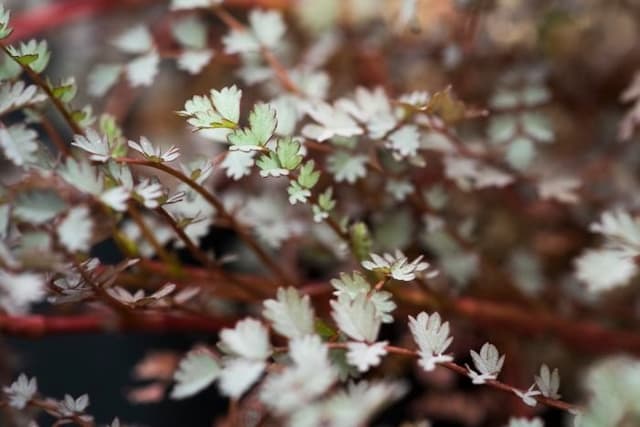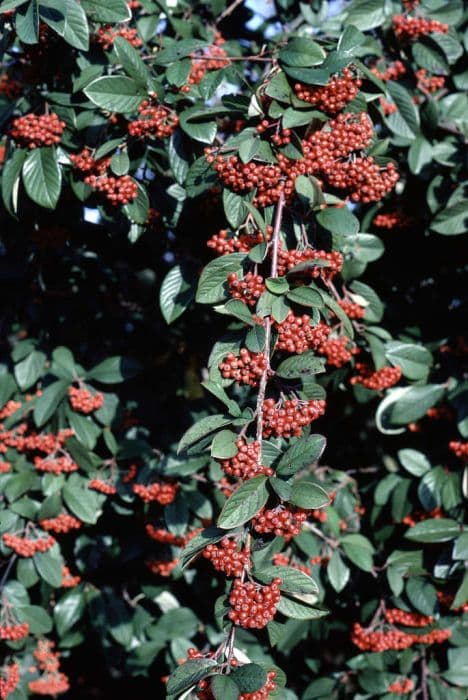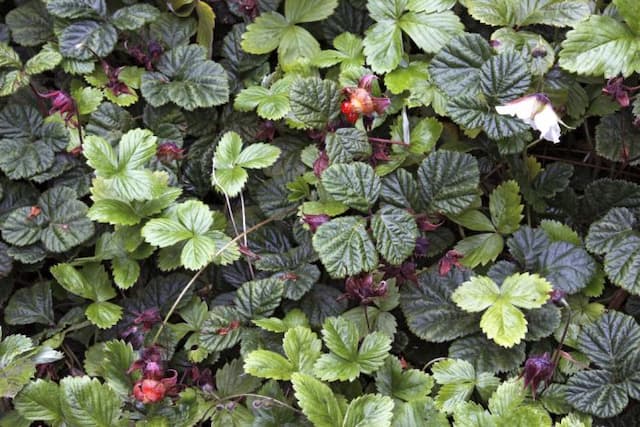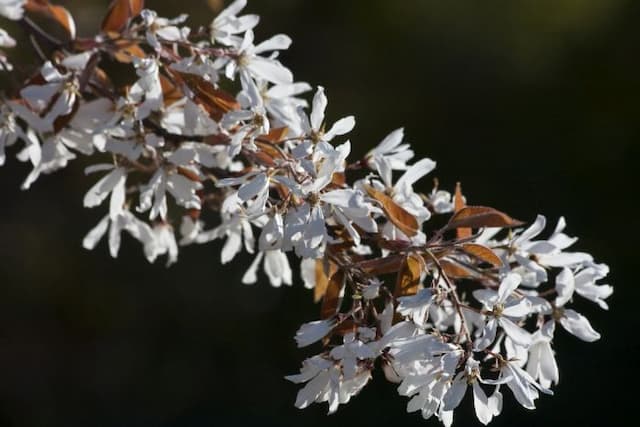Nepal Cinquefoil Potentilla nepalensis

ABOUT
Potentilla nepalensis, commonly known as Nepal cinquefoil, is a perennial plant with a visually appealing appearance that adds vibrant color to garden settings. The plant showcases a lush clump of strawberry-like foliage, with leaves divided into five leaflets that emanate from a central point, resembling fingers on a hand. The texture of the leaves is somewhat coarse, and their color is typically a rich green, creating a dense and attractive mat. One of the most charming attributes of the Nepal cinquefoil is its beautiful flowers. The blooms are carried on slender, branching stems that rise above the foliage, creating a delightful contrast. Each flower is composed of five petals that can vary in color from a deep, rosy pink to a lighter shade, occasionally with darker centers creating a bi-color effect. The petals are usually heart-shaped with slightly notched tips, and they are arranged around a center of numerous small, yellow stamens that contrast strikingly with the pink petals. For a perennial, the flowering season of the Nepal cinquefoil is quite generous, lasting from late spring to early fall, depending upon the climate. This long blooming period allows for an extended display of color in the garden. While blossoming, the plant presents a cottage garden charm that is hard to resist, attracting bees and butterflies that contribute to the bucolic appeal of the environment. Overall, the Nepal cinquefoil is a robust herbaceous plant that is well-loved for its lush foliage and cheerful, long-lasting flowers. It brings a splash of color and an easy-going grace to any garden space it inhabits.
About this plant
 Names
NamesFamily
Rosaceae.
Synonyms
Nepal Cinquefoil, Himalayan Cinquefoil, Nepalese Cinquefoil.
Common names
Potentilla dentata, Potentilla jackii, Potentilla brunonis var. nepalensis.
 Toxicity
ToxicityTo humans
Nepal Cinquefoil is generally not considered toxic to humans. There is limited information indicating significant toxicity upon ingestion, and it is not commonly associated with poisoning or adverse symptoms. However, as with any plant, individual allergies or sensitivities are possible, and it is always prudent to avoid ingesting plants that are not known to be edible or that have not been properly identified.
To pets
Nepal Cinquefoil is not known to be toxic to pets either. It is not listed among the commonly recognized poisonous plants for animals such as dogs or cats. As with humans, the risk of individual allergies or sensitivities exists, so it is wise to prevent pets from ingesting this plant. If a pet does ingest Nepal Cinquefoil and exhibits unusual symptoms, it is best to consult a veterinarian.
 Characteristics
CharacteristicsLife cycle
Perennials
Foliage type
Deciduous
Color of leaves
Green
Flower color
Pink
Height
1-2 feet (30-60 cm)
Spread
1-2 feet (30-60 cm)
Plant type
Herb
Hardiness zones
7
Native area
Himalayas
Benefits
 General Benefits
General Benefits- Aesthetic Appeal: Potentilla nepalensis, commonly known as Nepal cinquefoil, adds vibrant color and beauty to gardens with its lovely pink and red flowers.
- Ease of Care: Nepal cinquefoil is a low-maintenance plant, making it ideal for both novice and experienced gardeners.
- Drought Tolerance: Once established, this plant has good drought resistance, requiring minimal water during dry periods.
- Soil Adaptability: It can thrive in a variety of soil types, although it prefers well-drained soil.
- Attracts Pollinators: The blossoms of the Nepal cinquefoil attract bees, butterflies, and other beneficial pollinators, supporting biodiversity.
- Seasonal Interest: With its lengthy blooming period, from late spring to early fall, the plant adds prolonged interest to the landscape.
- Ground Cover: Its dense growth habit makes it an excellent choice for ground cover, reducing soil erosion and weed growth.
- Edging Plant: Due to its compact size and neat growth habit, it's well-suited for borders and edging paths or flower beds.
 Medical Properties
Medical Properties- Anti-inflammatory: Potentilla nepalensis is traditionally used to reduce inflammation in various conditions.
- Antiseptic: The plant has been used for its antiseptic properties to clean wounds and prevent infection.
- Astringent: Due to its astringent qualities, it may be utilized in stopping bleeding and tightening tissues.
- Gastrointestinal Aid: It is sometimes employed in herbal preparations to help alleviate digestive issues.
- Diuretic: Potentilla nepalensis may promote the production of urine, aiding in the removal of excess water from the body.
 Air-purifying Qualities
Air-purifying QualitiesThis plant is not specifically known for air purifying qualities.
 Other Uses
Other Uses- Potentilla nepalensis, commonly known as Cinquefoil, can be used as a natural dye for fabrics, yielding warm shades of yellow or gold.
- The plant is often utilized in ornamental gardens for its appealing foliage and attractive pink to red flowers that add aesthetic value to the landscape.
- Cinquefoil can serve as groundcover, thanks to its mat-forming growth habit, helping to reduce soil erosion on slopes and banks.
- Some gardeners use the dried flowers of Cinquefoil in potpourri mixes to create natural room fresheners with a gentle, pleasant scent.
- The plant has been incorporated into companion planting schemes, where it is believed to enhance the growth of some vegetables by attracting beneficial insects.
- Cinquefoil can be used in crafting natural floral arrangements, both fresh and dried, for decoration in homes and at special events.
- It can act as a natural border or edging plant in landscaping, creating visually distinct sections in garden beds or along walkways.
- The flowers of Cinquefoil can be pressed and used in the art of flower pressing, which involves preserving flowers for use in decorative crafts.
- In larger green spaces or parks, Cinquefoil can be planted to provide habitat and food for pollinators such as bees and butterflies.
- This plant may be used as an education tool in horticulture and botany programs to study the characteristics and growth patterns of herbaceous perennials.
Interesting Facts
 Feng Shui
Feng ShuiThe Cinquefoil is not used in Feng Shui practice.
 Zodiac Sign Compitability
Zodiac Sign CompitabilityThe Cinquefoil is not used in astrology practice.
 Plant Symbolism
Plant Symbolism- Endurance: Potentilla nepalensis, or the Cinquefoil, has a hardy nature and ability to thrive in various conditions, symbolizing endurance and resilience in the face of hardship.
- Protection: Historically, the Cinquefoil has been used in herbalism and magical practices for protection, its five-petaled flowers considered a powerful shield against evil.
- Maternal Love: The Cinquefoil's nurturing growth habit and caring for its blossoms reflect the nurturing aspect of maternal love and care.
- Wisdom: In certain folklore, the Cinquefoil is associated with wisdom, its leaves representing the balance of five senses and its presence in medicinal remedies showcasing knowledge of healing.
- Magical Power: With its pentagram shape reminiscent of mystical symbols, the Cinquefoil is thought to embody magical powers and is used in spells and enchantments for various purposes.
 Water
WaterThe Nepal Cinquefoil should be watered deeply but infrequently, allowing the soil to dry out slightly between watering sessions. Generally, providing about an inch of water once a week during the growing season is adequate. Adjustments should be made during hot, dry spells or rainy periods, ensuring the plant receives a consistent amount of moisture without becoming waterlogged. Over the winter months, reduce watering significantly, allowing the plant to rest. Always check the top couple of inches of soil for dryness before adding more water.
 Light
LightThe Nepal Cinquefoil thrives in full sun to partial shade. Ideally, position it where it can receive at least six hours of direct sunlight per day, while being protected from the harshest midday sun. A spot with morning sunlight and afternoon shade is optimal in areas with very hot summers.
 Temperature
TemperatureThe Nepal Cinquefoil can tolerate a wide temperature range but prefers a temperate climate. It can generally survive minimum temperatures down to around 10 degrees Fahrenheit but does best when temperatures remain above freezing. The ideal temperature for this plant ranges from 60 to 70 degrees Fahrenheit during the growing season.
 Pruning
PruningPrune Nepal Cinquefoil to maintain shape and encourage bushier growth. Deadhead spent flowers to promote continued blooming throughout the season. A more substantial pruning can be done in late winter or early spring, just before new growth begins. At this time, remove any dead or damaged branches and thin the plant to allow sunlight and air circulation within the canopy.
 Cleaning
CleaningAs needed
 Soil
SoilThe best soil mix for Cinquefoil (Potentilla nepalensis) should be well-draining with good fertility. A mixture that includes equal parts of garden soil, sand, and compost or peat will support healthy growth. The soil pH should be slightly acidic to neutral, ranging from 6.0 to 7.0 for optimal plant health.
 Repotting
RepottingCinquefoil (Potentilla nepalensis) generally doesn't require frequent repotting. It can be repotted every 2 to 3 years or when the plant has outgrown its current container. Spring is the ideal time for repotting to give the plant a fresh start for the growing season.
 Humidity & Misting
Humidity & MistingCinquefoil (Potentilla nepalensis) is tolerant of a range of humidity levels but prefers moderate atmospheric moisture. It thrives best in outdoor garden settings where the natural humidity is typically sufficient for its needs.
 Suitable locations
Suitable locationsIndoor
Provide bright light and well-draining soil mix.
Outdoor
Plant in full sun to part shade, well-draining soil.
Hardiness zone
5-8 USDA
 Life cycle
Life cyclePotentilla nepalensis, commonly known as the Nepal cinquefoil, begins its life as a seed, entering dormancy until conditions are favorable for germination, typically in the spring. Germination leads to the growth of a small seedling, which develops a root system and foliage as it matures. The plant enters a vegetative state where it grows leaves and stems, establishing itself and photosynthesizing to gather energy. During the flowering stage, which usually occurs in the summer, the Nepal cinquefoil produces pink to deep red flowers that attract pollinators, vital for sexual reproduction. Following pollination, the flowers develop into fruit containing seeds, which are dispersed by various means, including animals and natural elements. The plant may die back in winter in colder climates but can also behave as a perennial, resuming growth from the root system when conditions improve.
 Propogation
PropogationPropogation time
Spring to summer
For Himalayan cinquefoil or Potentilla nepalensis, the most popular method of propagation is by division. This is typically performed in the spring or early fall. To propagate by division, carefully lift the plant from the soil and gently separate it into smaller clumps, ensuring that each section has a portion of the root system intact. These clumps can then be immediately replanted into well-draining soil at the same depth they were originally growing. Water the newly planted divisions thoroughly to help establish them. This method of propagation is quick, ensures that the plants are true to the parent in terms of characteristics, and provides new plants that will mature faster than those grown from seed.









